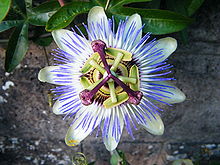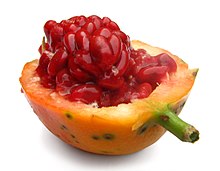Passiflora caerulea
| Passiflora caerulea | |
|---|---|
 |
|
| Passiflora caerulea in flower | |
 |
|
| Passiflora caerulea fruit cut and opened | |
| Scientific classification | |
| Kingdom: | Plantae |
| (unranked): | Angiosperms |
| (unranked): | Eudicots |
| (unranked): | Rosids |
| Order: | Malpighiales |
| Family: | Passifloraceae |
| Genus: | Passiflora |
| Species: | P. caerulea |
| Binomial name | |
|
Passiflora caerulea L. |
|
Passiflora caerulea, the blue passionflower,bluecrown passionflower or common passion flower, is a species of flowering plant native to South America (Argentina, Chile, Paraguay, Uruguay and Brazil). It is a vigorous, deciduous or semi-evergreen tendril vine growing to 10 m (33 ft) or more, with palmate leaves and fragrant, blue-white flowers with a prominent fringe of coronal filaments in bands of blue, white, and brown. The ovoid orange fruit, growing to 6 cm (2 in), is edible but bland.
This popular and showy plant has attracted a number of common names. In Paraguay it is widely known as mburucuyá in Guaraní. Other names include blue crown, flower of five wounds, southern beauty, wild apricot, Jesus flower. The specific epithet caerulea means "blue" and refers to the blue coronal filaments. In Japan, it's called 時計草 ( Clock plant ) due to having 12 petals, a central stamens and stigmas resembling a timepieces's winding mechanism, and curly green tendrils resembling wound springs.
Passiflora caerulea is a woody vine capable of growing to 15–20 m (50 to 65 ft) high where supporting trees are available. The leaves are alternate, palmately five-lobed like a spread hand (sometimes three or seven lobes), 10–18 cm (4 to 7 in) long and wide. The base of each leaf has a flagellate-twining tendril 5–10 cm (2 to 4 in) long, which twines around supporting vegetation to hold the plant up.
The flower is complex, about 10 cm (4 in) in diameter, with the five sepals and petals similar in appearance, whitish in colour, surmounted by a corona of blue or violet filaments, then five greenish-yellow stamens and three purple stigmas. The fruit is an oval orange-yellow berry 6 cm (2½ in) long by 4 cm (1½ in) in diameter, containing numerous seeds; it is eaten, and the seeds spread by mammals and birds. It is edible to humans, but bland in flavour. In tropical climates, it will flower all year round.
...
Wikipedia
